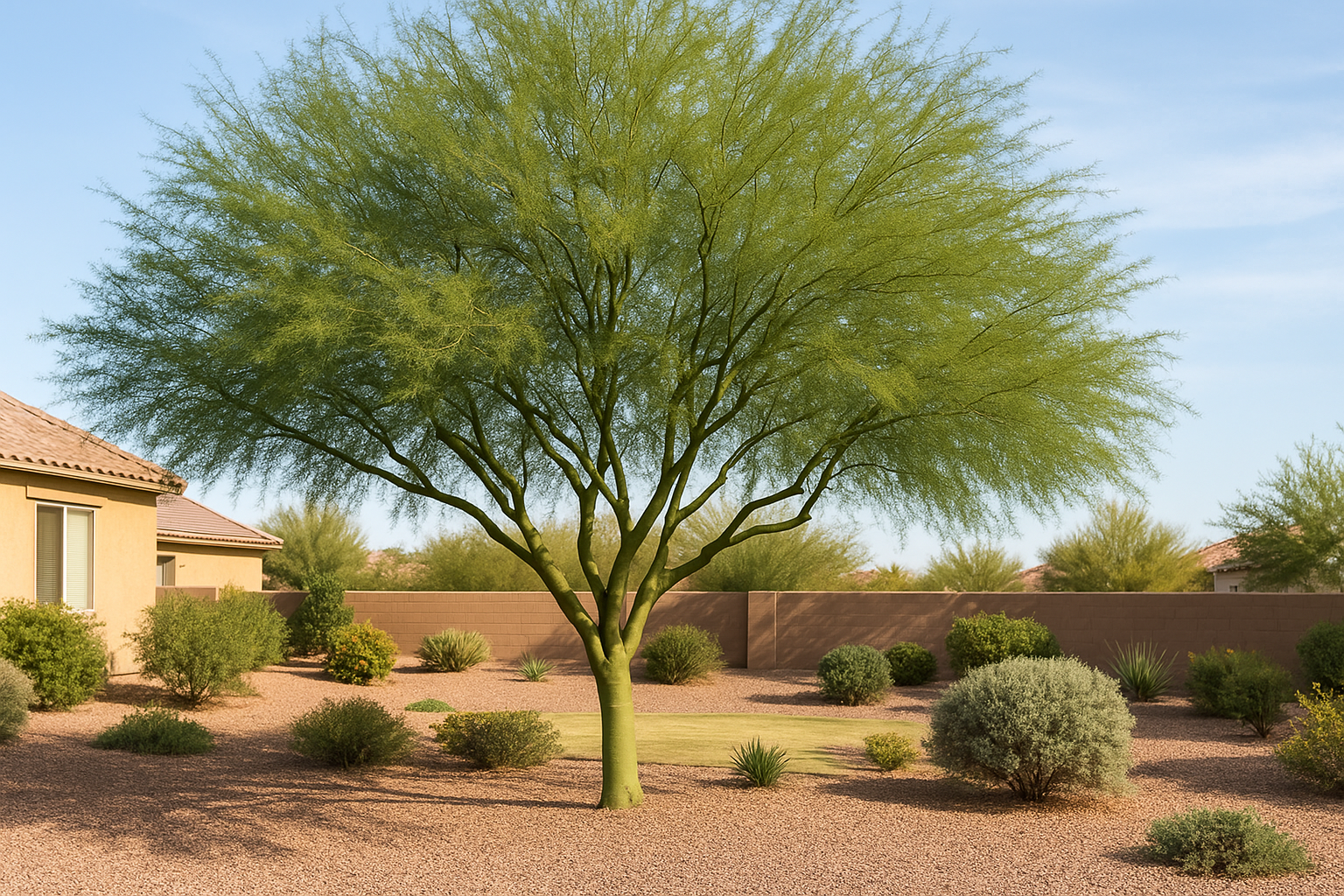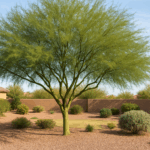Providing shade and beauty to your Gilbert home, Palo Verde trees are a cherished part of our local landscape. But to keep them in top form, pruning is essential. Not just any pruning, but well-timed and thoughtful cuts that promote shade and overall tree health. Whether you’re a seasoned gardener or a newbie, this guide will walk you through the best practices for pruning Palo Verde in Gilbert.

Understanding Palo Verde Trees
Palo Verde trees are native to the Sonoran Deserts in the Southwestern United States, thriving in our arid climate. Known for their bright yellow blooms and green bark, they make a stunning addition to Gilbert landscapes. Palo Verde translates to “green stick,” which aptly describes their green trunk and branches. This unique characteristic allows the tree to photosynthesize, a handy adaptation to life in the desert.
The Palo Verde is a deciduous tree, shedding its leaves during dry periods as a survival mechanism. This makes it a relatively low-maintenance tree for homeowners. However, without proper care and pruning, Palo Verde trees can become weak, susceptible to disease, and less aesthetically pleasing.
With thoughtful pruning, your Palo Verde can provide excellent shade, vibrant blooms, and a healthy living environment for local birds and pollinators. Let’s look at how and when to prune Palo Verde in Gilbert for optimal results.
When to Prune Palo Verde
Timing is crucial when it comes to pruning Palo Verde trees. The best time to prune is late winter or early spring, just before the new growth period. This allows the tree to recover quickly from the pruning and encourages healthy new growth. Remember, pruning during the hot summer months can cause the tree to go into shock, leading to branch dieback or even tree death.
Light pruning, such as removing dead or damaged branches, can be done at any time of the year. However, heavy pruning should be avoided during the growing season as it can stress the tree and lead to disease or pest infestations. The goal is to boost the tree’s health and shade, not hinder it.
As a rule of thumb, only prune up to 25% of the tree’s canopy in a single year. This ensures that enough foliage is left to support the tree’s growth and photosynthesis. Over-pruning can weaken the tree and make it more susceptible to diseases and pests.
How to Prune Palo Verde Trees
Pruning Palo Verde trees is a straightforward process but requires some knowledge and care. Always use clean, sharp tools to avoid disease transmission and ensure clean cuts. Loppers for smaller branches and a pruning saw for larger ones should suffice.
Start by removing any dead or diseased branches. These can be identified by their dark, shriveled appearance or presence of fungus. Cut these branches back to the point of healthy wood. Next, remove any branches that are rubbing against each other or growing inward. These cause unnecessary stress on the tree and can lead to breakages in high winds.
Prune to shape the tree and encourage a healthy, open canopy. This promotes good air circulation, preventing the onset of diseases and pests. Be mindful not to remove too much at once — gradual shaping over several seasons is healthier for the tree.
Finally, make your cuts at a slight angle, just beyond a bud or branch. This encourages new growth in the desired direction. Avoid making flush cuts against the trunk, as this can damage the tree and slow the healing process.
Kid-Friendly Tip: Pruning is a great opportunity to teach kids about plant care. Let them watch and explain why you’re removing certain branches. You can even let them help with picking up the cut branches. Make sure they’re wearing gloves and supervise them closely to ensure safety.
Aftercare and Maintenance
Once you’ve pruned your Palo Verde tree, it’s important to provide it with the necessary aftercare. Water it thoroughly after pruning to help it recover and encourage new growth. In the dry Gilbert climate, regular watering is vital, especially for newly pruned trees.
Keep an eye out for any signs of disease or pest infestations. If you notice anything unusual, such as discolored leaves or sawdust-like material at the base of the tree, consult with a local arborist or extension service.
Lastly, consider applying a layer of mulch around the base of the tree. This helps retain moisture, suppress weeds, and regulate soil temperature — all benefits that your Palo Verde will appreciate.
By following these guidelines for pruning Palo Verde in Gilbert, you’re sure to have a healthy, shade-giving, and beautiful tree enhancing your landscape. Happy pruning!






